-
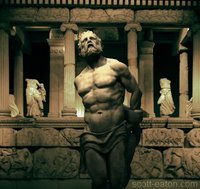 Prometheus and Digital Sculpture
Prometheus and Digital Sculpture “The piece is my [Eaton’s] own interpretation of the Prometheus myth, and is not based on any existing sculptures.”
-
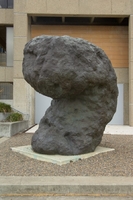 Prometheus (for Franz Kafka)
Prometheus (for Franz Kafka) “Tucker was a leading member of the New Generation of sculptors in London in the mid sixties. Their influence on Australian steel sculpture has continued to the present. Tucker however has moved on to other media and very different forms. This vast sculpture was made in plaster and cast directly in bronze. It suggests animated form being drawn up out of the earth. The cloud like volume may be seen as humanoid or as primal matter. Unlike other contemporary artists making large scale bronzes the original was modelled full size by the artist and not enlarged by technological processes. The surface is therefore a direct impression of the making process and the artist's gestures.”
-
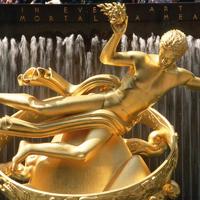 Prometheus
Prometheus “Prometheus is said to be the best-known sculpture in Rockefeller Center and the most photographed monumental sculpture in all of NYC. Created by famed American sculptor Paul Manship, who held a great fascination for mythological subjects and events, it has become the main attraction of the Lower Plaza. Its central theme is best stated by the quote that’s carved in the red granite wall behind him, taken from the sixth-century B.C. Greek dramatist Aeschylus: ‘Prometheus, Teacher in Every Art, Brought the Fire That Hath Proved to Mortals a Means to Mighty Ends.’”
-
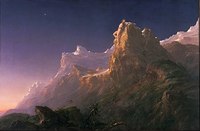 Prometheus Bound
Prometheus Bound “In classical mythology, Prometheus was an immortal giant who aided the human race by stealing fire from the gods. As punishment he was chained to Mount Caucasus in Scythia and condemned to have his liver plucked out by a vulture each day, only to have it renewed and then devoured again the next. Thomas Cole is best known as a landscape painter, and here the figure of Prometheus—the ostensible main subject of the painting—is secondary to the vast mountain range that surrounds him. Research suggests that Cole, an abolitionist, may have chosen this subject to create a moral allegory of the evils of slavery, symbolized most potently by the shackles that bind Prometheus to the rock.”
-
 Prometheus, naked, chained to a rock, looking up at an eagle standing over him
Prometheus, naked, chained to a rock, looking up at an eagle standing over him N/A
-
 Prometheus Bound
Prometheus Bound “In Greek mythology the Titan Prometheus stole fire from the gods on Mount Olympus to give to humanity. Furious, Zeus, king of the Olympians, ordered Prometheus forever chained to a rock, where each day an eagle would devour the Titan’s perpetually regenerating liver. This painting, which Rubens considered one of his most important works, represents the virtuoso artist at his absolute height. Working in collaboration, a common practice for master artists in Antwerp in the first two decades of the seventeenth century, Rubens and the famed animal and still-life painter Frans Snyders, who contributed the eagle, rendered the brutal tale of Prometheus with corresponding violence. The enormous bird’s beak rips open the Titan’s torso, exposing blood-soaked entrails. To gain purchase on the captive’s flesh, one of the eagle’s talons gouges Prometheus’s right eye. His left eye is locked on the predator, signaling he is fully aware of his torture, while his writhing legs, clenched fist, and tousled hair convey the Titan’s abject agony. Rubens, who intensively had studied the art he saw on his travels to Italy, Spain, and England, derived the hulking figure of Prometheus, with its broad frame and dense musculature, from prototypes by Michelangelo. The picture’s asymmetrical composition, in which Prometheus tumbles downward with his left arm almost reaching beyond the canvas, was inspired by a painting by Titian of the giant Tityus (1548–49; Museo del Prado, Madrid). Here Rubens masterfully synthesized and melded these sources with his own Baroque sensibilities. Christopher Atkins, from Philadelphia Museum of Art: Handbook. Philadelphia: Philadelphia Museum of Art, 2014, pp. 126–127.”
-
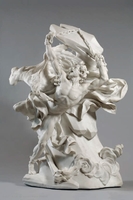 Prometheus, Chained to Mount Caucus, has his Liver Devoured by an Eagle
Prometheus, Chained to Mount Caucus, has his Liver Devoured by an Eagle “The Titan Prometheus, protector of men, stole fire from Mount Olympus. Furious, Zeus inflicted a terrible and cruel punishment on him. He chained him to the summit of Mount Caucasus, where an eagle came daily to peck at his liver, which constantly replenished itself. Prometheus, straining his every muscle, screams in agony. The instrument of his crime, the torch, lies at his feet.”
-
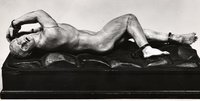 Untitled statuette
Untitled statuette “Statuette; ivory; carved; a nude figure in the form of Prometheus, who is shackled and chained at his wrists and ankle to a rock; the chains and rock are made of bronze, attached to a rectangular base by means of a screw with a washer in the form of a coin.”
-
 The creation of man by Prometeus
The creation of man by Prometeus “Prometeus, seated, is intent on observing his creature; the man, still a motionless clay puppet, stiffly lying at his feet, is surrounded by the greatest deities of the Greek pantheon. In a pre-eminent position there are Hera and Zeus in the act of giving Hermes the money with which to redeem the life of man from the Hades. Next to Hermes there is Poseidon with his trident; in the two upper corners, the chariot of Selene and the chariot of Apollo between Zeus and the man; finally, the Erotes induce Psyche, the soul, to give birth to the first human being.”
-
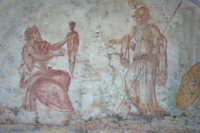 Untitled fresco
Untitled fresco “Roman fresco depicting Prometheus creating man in the presence of Athena, from the arcosolium of a tomb near the Basilica of St. Paul, 3rd century CE. (Museo della Via Ostiense, Rome).”
-
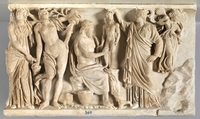 Prometheus models the first man
Prometheus models the first man “This fragment of a Roman sarcophagus depicts the Titan, Prometheus, modelling a statue of a nude youth. Minerva touches its head with a butterfly (psyche in Greek, meaning soul), bringing it to life. The action takes place in a natural setting, with a naked river nymph and a clothed tree nymph.”
-
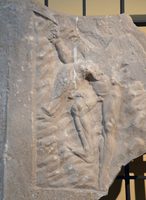 Untitled relief
Untitled relief “Relief decorating the seating area entrances of the Roman Amphitheatre of Capua (Italy). It depicts Prometheus having his liver eaten by an eagle. Age of Hadrian (117-138 CE). (Capua Gladiator Museum)”
-
 Untitled gem
Untitled gem “Gem of glass paste imitating sard, engraved with Herakles with a bow, lion-skin and club; before him sits Prometheus, draped about the legs, with his hands chained above his head.”
-
 Untitled scarab
Untitled scarab “Sard cut scarab engraved with a seated Prometheus making man: he attaches an arm to a skeleton. There is an inscription.”
-
 Herakles liberating Prometheus
Herakles liberating Prometheus
-
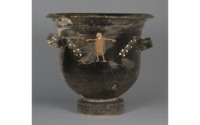 Gnathian Bell Krater
Gnathian Bell Krater “Black body with tendril of ivy leaves and grape clusters in added white. On the front, a figure of an old man with a swollen belly and an oversize phallus wearing a cloak stands in a rocky landscape. His wrists are bound. Below him to left is a crow. The scene is a parody of Prometheus bound to a rock having his liver eaten by an eagle.”
-
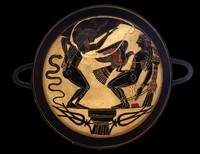 Laconic Kylix with Prometheus and Atlas
Laconic Kylix with Prometheus and Atlas “On this item we are able to admire one of the first known illustrations of the myth of Atlas, possibly directly inspired by the Theogony of Hesiod. Bearded Atlas bends at the knees under the weight of the heavenly vault dotted with stars that he has to carry, having been condemned by Zeus to keep heaven and earth separated. His punishment is associated with that of another Titan, his brother Prometheus, guilty of having given fire to man, and therefore bound to a pole and subjected to perpetual torture: an eagle pecks at his liver, which then regrows every night, only to be eaten again the following day. The linear plane on which the two Titans are depicted, possibly symbolising the Earth, rests on an imposing Doric column from which two lotus buds branch. The snake on the left may constitute a reference to the subterranean sphere of the underworld.”
 Prometheus and Digital Sculpture “The piece is my [Eaton’s] own interpretation of the Prometheus myth, and is not based on any existing sculptures.”
Prometheus and Digital Sculpture “The piece is my [Eaton’s] own interpretation of the Prometheus myth, and is not based on any existing sculptures.” Prometheus (for Franz Kafka) “Tucker was a leading member of the New Generation of sculptors in London in the mid sixties. Their influence on Australian steel sculpture has continued to the present. Tucker however has moved on to other media and very different forms. This vast sculpture was made in plaster and cast directly in bronze. It suggests animated form being drawn up out of the earth. The cloud like volume may be seen as humanoid or as primal matter. Unlike other contemporary artists making large scale bronzes the original was modelled full size by the artist and not enlarged by technological processes. The surface is therefore a direct impression of the making process and the artist's gestures.”
Prometheus (for Franz Kafka) “Tucker was a leading member of the New Generation of sculptors in London in the mid sixties. Their influence on Australian steel sculpture has continued to the present. Tucker however has moved on to other media and very different forms. This vast sculpture was made in plaster and cast directly in bronze. It suggests animated form being drawn up out of the earth. The cloud like volume may be seen as humanoid or as primal matter. Unlike other contemporary artists making large scale bronzes the original was modelled full size by the artist and not enlarged by technological processes. The surface is therefore a direct impression of the making process and the artist's gestures.” Prometheus “Prometheus is said to be the best-known sculpture in Rockefeller Center and the most photographed monumental sculpture in all of NYC. Created by famed American sculptor Paul Manship, who held a great fascination for mythological subjects and events, it has become the main attraction of the Lower Plaza. Its central theme is best stated by the quote that’s carved in the red granite wall behind him, taken from the sixth-century B.C. Greek dramatist Aeschylus: ‘Prometheus, Teacher in Every Art, Brought the Fire That Hath Proved to Mortals a Means to Mighty Ends.’”
Prometheus “Prometheus is said to be the best-known sculpture in Rockefeller Center and the most photographed monumental sculpture in all of NYC. Created by famed American sculptor Paul Manship, who held a great fascination for mythological subjects and events, it has become the main attraction of the Lower Plaza. Its central theme is best stated by the quote that’s carved in the red granite wall behind him, taken from the sixth-century B.C. Greek dramatist Aeschylus: ‘Prometheus, Teacher in Every Art, Brought the Fire That Hath Proved to Mortals a Means to Mighty Ends.’” Prometheus Bound “In classical mythology, Prometheus was an immortal giant who aided the human race by stealing fire from the gods. As punishment he was chained to Mount Caucasus in Scythia and condemned to have his liver plucked out by a vulture each day, only to have it renewed and then devoured again the next. Thomas Cole is best known as a landscape painter, and here the figure of Prometheus—the ostensible main subject of the painting—is secondary to the vast mountain range that surrounds him. Research suggests that Cole, an abolitionist, may have chosen this subject to create a moral allegory of the evils of slavery, symbolized most potently by the shackles that bind Prometheus to the rock.”
Prometheus Bound “In classical mythology, Prometheus was an immortal giant who aided the human race by stealing fire from the gods. As punishment he was chained to Mount Caucasus in Scythia and condemned to have his liver plucked out by a vulture each day, only to have it renewed and then devoured again the next. Thomas Cole is best known as a landscape painter, and here the figure of Prometheus—the ostensible main subject of the painting—is secondary to the vast mountain range that surrounds him. Research suggests that Cole, an abolitionist, may have chosen this subject to create a moral allegory of the evils of slavery, symbolized most potently by the shackles that bind Prometheus to the rock.” Prometheus, naked, chained to a rock, looking up at an eagle standing over him N/A
Prometheus, naked, chained to a rock, looking up at an eagle standing over him N/A Prometheus Bound “In Greek mythology the Titan Prometheus stole fire from the gods on Mount Olympus to give to humanity. Furious, Zeus, king of the Olympians, ordered Prometheus forever chained to a rock, where each day an eagle would devour the Titan’s perpetually regenerating liver. This painting, which Rubens considered one of his most important works, represents the virtuoso artist at his absolute height. Working in collaboration, a common practice for master artists in Antwerp in the first two decades of the seventeenth century, Rubens and the famed animal and still-life painter Frans Snyders, who contributed the eagle, rendered the brutal tale of Prometheus with corresponding violence. The enormous bird’s beak rips open the Titan’s torso, exposing blood-soaked entrails. To gain purchase on the captive’s flesh, one of the eagle’s talons gouges Prometheus’s right eye. His left eye is locked on the predator, signaling he is fully aware of his torture, while his writhing legs, clenched fist, and tousled hair convey the Titan’s abject agony. Rubens, who intensively had studied the art he saw on his travels to Italy, Spain, and England, derived the hulking figure of Prometheus, with its broad frame and dense musculature, from prototypes by Michelangelo. The picture’s asymmetrical composition, in which Prometheus tumbles downward with his left arm almost reaching beyond the canvas, was inspired by a painting by Titian of the giant Tityus (1548–49; Museo del Prado, Madrid). Here Rubens masterfully synthesized and melded these sources with his own Baroque sensibilities. Christopher Atkins, from Philadelphia Museum of Art: Handbook. Philadelphia: Philadelphia Museum of Art, 2014, pp. 126–127.”
Prometheus Bound “In Greek mythology the Titan Prometheus stole fire from the gods on Mount Olympus to give to humanity. Furious, Zeus, king of the Olympians, ordered Prometheus forever chained to a rock, where each day an eagle would devour the Titan’s perpetually regenerating liver. This painting, which Rubens considered one of his most important works, represents the virtuoso artist at his absolute height. Working in collaboration, a common practice for master artists in Antwerp in the first two decades of the seventeenth century, Rubens and the famed animal and still-life painter Frans Snyders, who contributed the eagle, rendered the brutal tale of Prometheus with corresponding violence. The enormous bird’s beak rips open the Titan’s torso, exposing blood-soaked entrails. To gain purchase on the captive’s flesh, one of the eagle’s talons gouges Prometheus’s right eye. His left eye is locked on the predator, signaling he is fully aware of his torture, while his writhing legs, clenched fist, and tousled hair convey the Titan’s abject agony. Rubens, who intensively had studied the art he saw on his travels to Italy, Spain, and England, derived the hulking figure of Prometheus, with its broad frame and dense musculature, from prototypes by Michelangelo. The picture’s asymmetrical composition, in which Prometheus tumbles downward with his left arm almost reaching beyond the canvas, was inspired by a painting by Titian of the giant Tityus (1548–49; Museo del Prado, Madrid). Here Rubens masterfully synthesized and melded these sources with his own Baroque sensibilities. Christopher Atkins, from Philadelphia Museum of Art: Handbook. Philadelphia: Philadelphia Museum of Art, 2014, pp. 126–127.” Prometheus, Chained to Mount Caucus, has his Liver Devoured by an Eagle “The Titan Prometheus, protector of men, stole fire from Mount Olympus. Furious, Zeus inflicted a terrible and cruel punishment on him. He chained him to the summit of Mount Caucasus, where an eagle came daily to peck at his liver, which constantly replenished itself. Prometheus, straining his every muscle, screams in agony. The instrument of his crime, the torch, lies at his feet.”
Prometheus, Chained to Mount Caucus, has his Liver Devoured by an Eagle “The Titan Prometheus, protector of men, stole fire from Mount Olympus. Furious, Zeus inflicted a terrible and cruel punishment on him. He chained him to the summit of Mount Caucasus, where an eagle came daily to peck at his liver, which constantly replenished itself. Prometheus, straining his every muscle, screams in agony. The instrument of his crime, the torch, lies at his feet.” Untitled statuette “Statuette; ivory; carved; a nude figure in the form of Prometheus, who is shackled and chained at his wrists and ankle to a rock; the chains and rock are made of bronze, attached to a rectangular base by means of a screw with a washer in the form of a coin.”
Untitled statuette “Statuette; ivory; carved; a nude figure in the form of Prometheus, who is shackled and chained at his wrists and ankle to a rock; the chains and rock are made of bronze, attached to a rectangular base by means of a screw with a washer in the form of a coin.” The creation of man by Prometeus “Prometeus, seated, is intent on observing his creature; the man, still a motionless clay puppet, stiffly lying at his feet, is surrounded by the greatest deities of the Greek pantheon. In a pre-eminent position there are Hera and Zeus in the act of giving Hermes the money with which to redeem the life of man from the Hades. Next to Hermes there is Poseidon with his trident; in the two upper corners, the chariot of Selene and the chariot of Apollo between Zeus and the man; finally, the Erotes induce Psyche, the soul, to give birth to the first human being.”
The creation of man by Prometeus “Prometeus, seated, is intent on observing his creature; the man, still a motionless clay puppet, stiffly lying at his feet, is surrounded by the greatest deities of the Greek pantheon. In a pre-eminent position there are Hera and Zeus in the act of giving Hermes the money with which to redeem the life of man from the Hades. Next to Hermes there is Poseidon with his trident; in the two upper corners, the chariot of Selene and the chariot of Apollo between Zeus and the man; finally, the Erotes induce Psyche, the soul, to give birth to the first human being.” Untitled fresco “Roman fresco depicting Prometheus creating man in the presence of Athena, from the arcosolium of a tomb near the Basilica of St. Paul, 3rd century CE. (Museo della Via Ostiense, Rome).”
Untitled fresco “Roman fresco depicting Prometheus creating man in the presence of Athena, from the arcosolium of a tomb near the Basilica of St. Paul, 3rd century CE. (Museo della Via Ostiense, Rome).” Prometheus models the first man “This fragment of a Roman sarcophagus depicts the Titan, Prometheus, modelling a statue of a nude youth. Minerva touches its head with a butterfly (psyche in Greek, meaning soul), bringing it to life. The action takes place in a natural setting, with a naked river nymph and a clothed tree nymph.”
Prometheus models the first man “This fragment of a Roman sarcophagus depicts the Titan, Prometheus, modelling a statue of a nude youth. Minerva touches its head with a butterfly (psyche in Greek, meaning soul), bringing it to life. The action takes place in a natural setting, with a naked river nymph and a clothed tree nymph.” Untitled relief “Relief decorating the seating area entrances of the Roman Amphitheatre of Capua (Italy). It depicts Prometheus having his liver eaten by an eagle. Age of Hadrian (117-138 CE). (Capua Gladiator Museum)”
Untitled relief “Relief decorating the seating area entrances of the Roman Amphitheatre of Capua (Italy). It depicts Prometheus having his liver eaten by an eagle. Age of Hadrian (117-138 CE). (Capua Gladiator Museum)” Untitled gem “Gem of glass paste imitating sard, engraved with Herakles with a bow, lion-skin and club; before him sits Prometheus, draped about the legs, with his hands chained above his head.”
Untitled gem “Gem of glass paste imitating sard, engraved with Herakles with a bow, lion-skin and club; before him sits Prometheus, draped about the legs, with his hands chained above his head.” Untitled scarab “Sard cut scarab engraved with a seated Prometheus making man: he attaches an arm to a skeleton. There is an inscription.”
Untitled scarab “Sard cut scarab engraved with a seated Prometheus making man: he attaches an arm to a skeleton. There is an inscription.” Herakles liberating Prometheus
Herakles liberating Prometheus
 Gnathian Bell Krater “Black body with tendril of ivy leaves and grape clusters in added white. On the front, a figure of an old man with a swollen belly and an oversize phallus wearing a cloak stands in a rocky landscape. His wrists are bound. Below him to left is a crow. The scene is a parody of Prometheus bound to a rock having his liver eaten by an eagle.”
Gnathian Bell Krater “Black body with tendril of ivy leaves and grape clusters in added white. On the front, a figure of an old man with a swollen belly and an oversize phallus wearing a cloak stands in a rocky landscape. His wrists are bound. Below him to left is a crow. The scene is a parody of Prometheus bound to a rock having his liver eaten by an eagle.” Laconic Kylix with Prometheus and Atlas “On this item we are able to admire one of the first known illustrations of the myth of Atlas, possibly directly inspired by the Theogony of Hesiod. Bearded Atlas bends at the knees under the weight of the heavenly vault dotted with stars that he has to carry, having been condemned by Zeus to keep heaven and earth separated. His punishment is associated with that of another Titan, his brother Prometheus, guilty of having given fire to man, and therefore bound to a pole and subjected to perpetual torture: an eagle pecks at his liver, which then regrows every night, only to be eaten again the following day. The linear plane on which the two Titans are depicted, possibly symbolising the Earth, rests on an imposing Doric column from which two lotus buds branch. The snake on the left may constitute a reference to the subterranean sphere of the underworld.”
Laconic Kylix with Prometheus and Atlas “On this item we are able to admire one of the first known illustrations of the myth of Atlas, possibly directly inspired by the Theogony of Hesiod. Bearded Atlas bends at the knees under the weight of the heavenly vault dotted with stars that he has to carry, having been condemned by Zeus to keep heaven and earth separated. His punishment is associated with that of another Titan, his brother Prometheus, guilty of having given fire to man, and therefore bound to a pole and subjected to perpetual torture: an eagle pecks at his liver, which then regrows every night, only to be eaten again the following day. The linear plane on which the two Titans are depicted, possibly symbolising the Earth, rests on an imposing Doric column from which two lotus buds branch. The snake on the left may constitute a reference to the subterranean sphere of the underworld.”